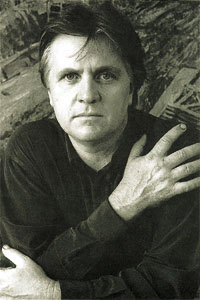
“I See My Work As Being About Compassion” [Archives:2001/07/Last Page]
February 12 2001
Hisham Al-Qubati,
Yemen Times
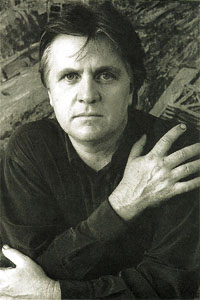
The exhibition included a number of far-fetched paintings depicting the miseries and tragedies of wars in general and land-mines in particular. Pictures like ‘In The Yellow Room’ from Afghanistan, ‘Sahida’, the ambassador for land-mine victims, who lost both her legs to a land mine and prior to that lost her husband in a similar incident, and ‘Too Young To Understand Yet’ of a young intelligent boy who lost both his legs to a land-mine yet was determined to go back to school and get ahead of his classmates, created sympathy and commitment inside everybody to fight land-mines.
One of the interesting features in George’s paintings, although they picture tragedy and pain, is that they are done in a way that show bravery, courage and strength in his characters despite their miserable condition.
George Gittoes expressed happiness for being in Yemen, the first Arab and Islamic country to sign a treaty banning anti-personnel land-mines. He expressed his hope that he will return to Yemen again along with his wife, Gabrielle, and his children, to stay for a longer time and collect stories about Yemen to show them world wide.
The Exhibition included a 20-minute slide show accompanied by a commentary by the artist himself. A day before the exhibition, George gave a workshop attended by more than 40 participants including artists, poets, short story writers, etc. During the workshop, the possibility of creating an international exchange with Yemeni artists and setting up some kind of network was discussed so that their works can be more widely appreciated across the world.
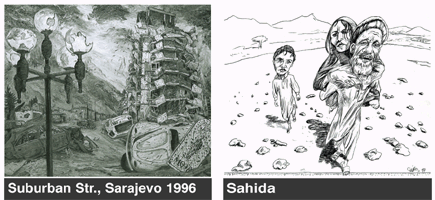
It may be worthwhile to mention that an artists’ main job is to capture beauty. This is true, but some go beyond this, making their works records of history. George Gittoes is one of those contemporary artists who travel to places that devils dare not tread and encounter tragedies of life in all credible and incredible forms. With a pencil and a brush, you are not only given a photo but a full story that makes viewers see a complete, live picture of brave struggle and strife.
Having heard about Yemen as the first Arab country to sign a treaty banning anti-personnel land mines, and being invited by the Minister of Cabinet Affairs when they met once in Geneva, he thought it would be wonderful to come to Yemen, a country about whose ancient culture he had read a lot. At the time of invitation “I was holding an exhibition to support the banning of land-mines. So I thought it would be wonderful to come to Yemen and show my support,” said George.
“All my life I have studied Islamic culture. I have been fascinated by Yemen and its long-written history and architecture. I have always wanted to come to this oldest part of Islam,” he added.
George said that he came to Yemen in order to gather stories about land-mine victims to include them in the International Touring Exhibition which was set up to gain support for de mining.
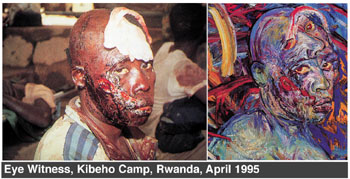
George’s last works have been devoted to humanity and tell the stories of land-mine victims. “In many ways I see my art as being an advocate to the case of the voiceless victims of land-mines,” he said.
Whenever George collects a story he tries to give it the kind of a spiritual twist which you get in Islamic literature. Although a non-Moslem, George has read the Holy Quran and loves Islamic culture. This motivates him to act as a bridge between the Islamic world and the rest of the world. “I feel that there is a terrible misunderstanding at the moment between Muslims and the world. There are many countries, specially America, which don’t understand the intellectual history, spirituality and culture of the Islamic world,” he said.
A huge body of his works aims at creating a bridge between Islam and the rest of the world. Most of the pieces earmarked for his current exhibition in Sana’a were examples of the artist’s travels throughout the Islamic world.
Like brave journalists crossing the lines, George has witnessed the bloodiest conflicts of our time: Vietnam, Nicaragua, the Philippines, Cambodia, Somalia, Rwanda, the Western Sahara, Palestine, South Lebanon, South Africa, Bosnia, etc. However, he emphasizes that artists are absolutely different from journalists. He said: “As an artist you have to sit down with people to know them. The closer you become to them, the more you become involved. What you can produce in a drawing or a painting is more than what a camera can do. You are often expressing something quite abstract and spiritual which you can never do with a camera.
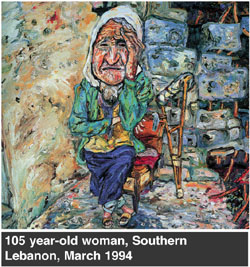
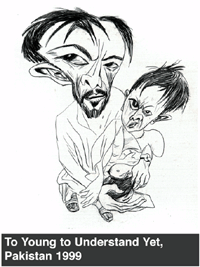
To draw someone takes a long time and you create a bond between you and him/her. But a photographer can go and take photos and never get to know them or even their names. And in minutes they are out of the scene and away from it, they do not even come close to it. But as an artist you get very close to them. You stay with the person long enough to know their story. You can not walk away from him and say good-bye, I will never see you again. They also see what you do, but with a photographer they never know. So this exhibition is showing how there is still an edge for the artist to work with humanity.”
“One of the problems, particularly in reports on Islam in the west, is that photographs can be interpreted in a way different than the truth. I understand that a lot of people become suspicious of journalists because they know that photographs can be changed. But when you are doing the drawing, I can sit down and see what you have done. I know what you do. I can say that you are misrepresenting me but I can’t see what is in a camera,” he added.
Another interesting thing about the artist is that what he publishes motivates him to go back to the same sources. He has got the courage to go back and sit down with the people he draws and hear them requesting more copies. “We love it. We want to give it to our relatives,” they say. They love to read the stories because they know they are telling the truth.
“I am happy to go back to Hebron, Capol, Herat, etc., and take the stories back, whereas a lot of journalists who distort the truth will never be welcome back. It is a different process,” said George.
From Yemen, George is heading for South Africa, a place he recognizes well for he covered many terrible events there. “Whenever a country passes through trouble, years later, they feel glad that I did what I did because it documents the struggle that they don’t want forgotten,” he concluded.
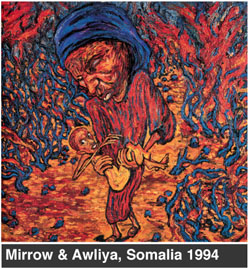
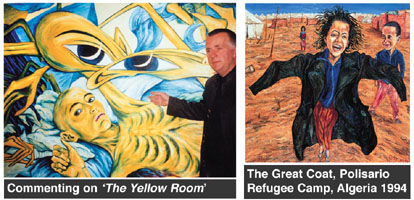
——
[archive-e:07-v:2001-y:2001-d:2001-02-12-p:./2001/iss07/lastpage.htm]


